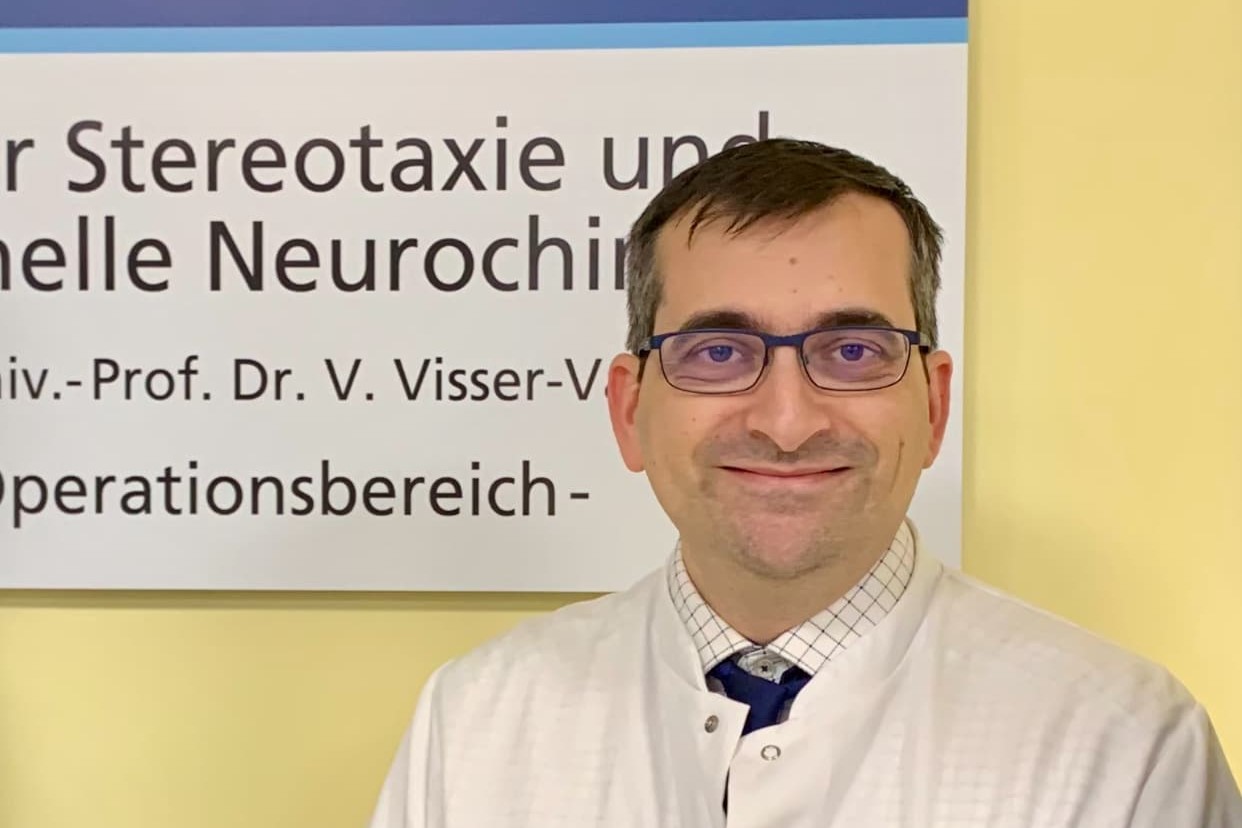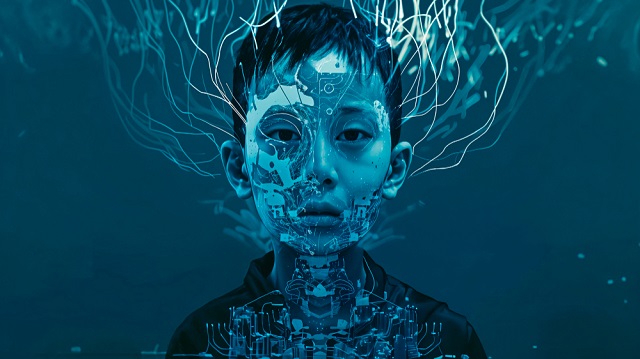Dr. Georgios Matis, currently a Senior Consultant in Neurosurgery at University Cologne Hospital, has forged a remarkable path in the field of chronic pain and spasticity management. His journey began at Aristotle University in Thessaloniki, Greece, where he completed his medical studies. Following this, he undertook his residency in neurosurgery in Thessaloniki. A fortuitous meeting with Dr. A. Koulousakis, who would become his mentor, opened up a new world for Dr. Matis. Under Dr. Koulousakis’s guidance, he delved into functional neurosurgery and neuromodulation, discovering how therapies like spinal cord stimulation (SCS) and intrathecal therapy (pump therapy) could significantly reduce chronic pain and spasticity. Witnessing the transformative impact of these therapies on patients’ functional outcomes and quality of life, Dr. Matis decided to immerse himself in this dynamic and rewarding field. This decision has proven to be the most fulfilling professional choice of his career.
Leadership and Innovation: Shaping the Pain/Spasticity Section at Uniklinik Köln
In his role as the Head of the Pain/Spasticity Section at Uniklinik Köln, Dr. Matis has had the opportunity to develop tailored treatment plans for individual patients, combining modern technology, clinical medicine, and even ancient Greek philosophy. His holistic approach to patient care emphasizes open communication, understanding patients’ needs, and addressing the physical, cognitive, and emotional components of their conditions. Dr. Matis’s leadership has led to a more philosophy-based treatment approach that integrates the latest technological advancements in the field. This position has not only allowed him to grow as a professional but also as a person, shaping his vision for patient-centric care.
Integrating Research and Clinical Practice: Delivering Innovative Care
Dr. Matis’s dedication to neuroscience research fundamentally shapes his approach to patient care. His clinical observations inform research questions, while scientific discoveries enhance his treatment strategies. For example, his work on salvage therapy in spinal cord stimulation has led him to develop personalized protocols that incorporate the latest findings on habituation and loss of efficacy. Dr. Matis constantly analyzes patients’ responses through both a clinical and research lens, allowing him to fine-tune interventions based on emerging scientific evidence. This integrative approach has enabled him to pioneer novel therapeutic techniques, including closed-loop stimulation and artificial intelligence. By maintaining an active research program alongside his clinical practice, Dr. Matis ensures that his patients benefit from cutting-edge developments, while their unique cases contribute valuable insights to the broader field of neuroscience.
Balancing Clinical Practice with Advancing Education and Research
Balancing clinical practice with academic contributions requires viewing these roles as complementary rather than competing priorities. Dr. Matis’s clinical work provides invaluable real-world insights that inform his research questions and educational initiatives, while his research endeavors help him bring cutting-edge knowledge and evidence-based approaches back to patient care. He dedicates specific blocks of time for research and writing, often early mornings or designated academic days, allowing him to maintain this balance effectively. Dr. Matis views teaching opportunities, whether through mentoring colleagues, presenting at conferences, or contributing to publications, as natural extensions of patient care that multiply the impact of clinical insights across the broader medical community. This integrated approach allows him to stay grounded in day-to-day patient care while simultaneously contributing to the advancement of the field through scholarly work.
Neuromodulation and Chronic Pain Management: Transformative Advances
Over the past decade, several transformative advances in neuromodulation have significantly impacted Dr. Matis’s practice. One such advancement is closed-loop stimulation in spinal cord stimulation (SCS), which allows the leads to both stimulate the spinal cord and measure its response simultaneously. This technology is based on measuring evoked compound action potentials (ECAPs). Another significant advancement is the use of artificial intelligence in SCS, which enables the adjustment of stimulation programs based on patient feedback, the cause of pain, and the collective experience of thousands of patients. These innovations have revolutionized chronic pain and spasticity management, providing patients with more precise and effective treatments.
Impact of Modern Neuromodulation Techniques
Modern neuromodulation techniques, such as spinal cord stimulation (SCS), peripheral nerve field stimulation, and intrathecal therapies, have revolutionized chronic pain and spasticity management. SCS delivers carefully calibrated electrical pulses that override pain signals before they reach the brain, while peripheral nerve field stimulation targets specific nerve clusters closer to the skin’s surface, providing focused relief in particular body regions. Intrathecal therapy uses surgically implanted pumps to deliver precise doses of medication directly into the spinal fluid, achieving powerful therapeutic effects with smaller drug quantities than oral medications require. These advanced interventions have dramatically improved the quality of life for many patients, reducing their reliance on opioids and other systemic medications while achieving better pain control and muscle function. The success of these treatments stems from their ability to modulate neural signaling patterns with unprecedented precision, essentially “retraining” the nervous system’s response to chronic pain and muscle tension.
Artificial Intelligence in Chronic Pain Management
Artificial intelligence (AI) is revolutionizing the field of neuromodulation, particularly in spinal cord stimulation (SCS) systems, by enabling more personalized and adaptive pain management approaches. Modern SCS systems leverage machine learning algorithms to analyze real-time neural signals and patient feedback, continuously optimizing stimulation parameters to provide more effective pain relief. AI systems in conjunction with closed-loop technology can detect subtle patterns in pain signals and automatically adjust the stimulation frequency, amplitude, and waveform patterns, moving beyond the traditional “one-size-fits-all” approach. The explainable AI component of these systems provides clinicians with clear insights into why specific stimulation adjustments are being made, allowing for better oversight and patient care management. This technological advancement represents a significant shift from static programming to dynamic, responsive neuromodulation that adapts to each patient’s unique pain patterns and daily activities, ultimately leading to improved outcomes and quality of life for chronic pain patients.
Future Integration of Emerging Technologies with Neuromodulation
The future of pain management through neuromodulation appears poised for revolutionary advances through the integration of emerging technologies like AI, machine learning, and advanced biosensors. We can envision smart neuromodulation devices that continuously learn from individual patient responses and automatically adjust stimulation parameters in real-time, using AI algorithms to optimize pain relief while minimizing side effects. These systems could incorporate advanced biosensors that monitor not just pain signals but also mood, stress levels, and physical activity, creating a comprehensive understanding of each patient’s pain experience. The integration of cloud computing and secure data networks could enable these devices to share anonymized data across medical centers worldwide, leading to increasingly sophisticated treatment protocols based on vast amounts of clinical evidence. Additionally, the miniaturization of components and advancement in battery technology could make these devices less invasive and longer-lasting, while augmented reality interfaces could provide patients and healthcare providers with intuitive ways to monitor and adjust treatments. This convergence of technologies promises to transform neuromodulation from a standardized treatment into a highly personalized, responsive, and effective approach to chronic pain management.
Addressing Patient Concerns: Building Trust and Confidence
Dr. Matis understands that patient skepticism or fear regarding neuromodulation procedures can be a significant barrier to treatment. To address these challenges, he emphasizes building trust through transparent communication and patient education. Dr. Matis takes the time to thoroughly explain the scientific principles behind neuromodulation in accessible terms, using visual aids and relatable analogies to demystify the technology. He acknowledges patients’ fears as valid and presents evidence-based data about the safety and efficacy of these procedures. By sharing success stories from other patients and walking through each step of the procedure in detail, Dr. Matis helps reduce anxiety about the unknown. Most importantly, he creates space for patients to voice their specific concerns and questions, treating each person’s journey with neuromodulation as unique and deserving of individualized attention and support. This patient-centered approach, combined with thorough education and emotional validation, has proven effective in helping patients feel more confident about pursuing neuromodulation as a treatment option.
Transformative Patient Cases: Illustrating the Power of Neuromodulation
Dr. Matis has witnessed numerous transformative patient cases that illustrate the potential of neuromodulation to change lives. One particularly memorable case involves a 45-year-old former athlete who had suffered from severe, treatment-resistant Complex Regional Pain Syndrome (CRPS) for over a decade. Despite trying multiple medications and therapies, the patient had found no relief and had become increasingly isolated and unable to work. Through careful electrode placement and optimization of stimulation parameters, Dr. Matis implemented spinal cord stimulation (SCS) for the patient. Over several months, the patient experienced a gradual but profound lifting of pain symptoms. Most notably, she described feeling “present in her own life again” and was able to return to work, rebuild relationships with her family, and even resume coaching youth sports – activities that had seemed impossible during her years of pain. This case exemplifies how neuromodulation, while not a cure-all, can offer hope and concrete improvements in quality of life for carefully selected patients who haven’t responded to conventional treatments.
Lessons in Leadership and Collaboration
Leading the pain and spasticity section has reinforced Dr. Matis’s deep belief that effective healthcare leadership requires both clinical expertise and emotional intelligence. Through collaborating with diverse team members—from nurses and physical therapists to pain specialists and administrative staff—Dr. Matis has learned that creating an environment of psychological safety, where every voice is valued, leads to better patient outcomes and innovative solutions. The challenges of managing complex pain cases have taught him that empowering team members to contribute their unique perspectives, while maintaining clear communication channels and shared goals, is essential for delivering comprehensive patient care. Most importantly, Dr. Matis has discovered that authentic leadership means being willing to remain humble, acknowledge uncertainties, and grow alongside the team as medical knowledge and treatment approaches continue to evolve.
Empowering Teams and Inspiring Innovation
Dr. Matis believes that the key to empowering his team lies in creating an environment where innovation and compassionate care naturally flourish together. By fostering open dialogue and celebrating both small improvements and bold ideas from every team member, he has developed a culture where staff feel confident experimenting with new approaches while keeping patient well-being at the center of everything they do. Regular innovation rounds where team members can share challenges and brainstorm solutions collectively, along with a mentorship program pairing experienced staff with newer team members, have led to numerous improvements in processes and outcomes. This combination of structured support and creative freedom, anchored by an unwavering commitment to exceptional patient care, has led to streamlined admission procedures and more personalized care plans. Success is measured not just through traditional metrics, but through the smiles of satisfied patients and the pride the team takes in knowing they are making a meaningful difference in people’s lives.
Advocacy and Personal Insights
As an Editorial Board Member for Neuromodulation: Technology at the Neural Interface, Dr. Matis uses social media to bridge the gap between scientific advancements and the broader medical community. By sharing key research findings, highlighting innovative therapies, and engaging in discussions on platforms like LinkedIn and Twitter, he aims to educate clinicians, researchers, and patients about the evolving role of neuromodulation in chronic pain management. Social media allows for real-time knowledge exchange, fostering collaboration and ensuring that groundbreaking treatments reach those who need them most.
Dr. Matis’s passion for helping patients achieve substantial pain relief and a better quality of life stems from witnessing the profound impact that effective neuromodulation therapies can have on those suffering from chronic pain. Every patient’s journey is unique, and he finds great fulfillment in combining cutting-edge technology with a patient-centered approach to tailor treatments that restore function and hope. Seeing someone regain mobility, independence, or even simple joys like walking their dog fuels his commitment to advancing pain management and mentoring the next generation of specialists to push the field even further.
Future Vision: Evolving Neuromodulation
The future of neuromodulation lies in a more personalized, intelligent, and adaptive approach to pain management. With advancements in closed-loop stimulation, artificial intelligence, and the combination of waveforms, therapies are moving towards a dynamic model that responds to each patient’s unique neural signals, optimizing efficacy while minimizing side effects. This represents a shift from rigid, pre-set programming to a more interactive and patient-centered model. A key challenge remains the effective treatment of mixed pain states, where integrating multiple neuromodulation strategies will be essential. Dr. Matis envisions contributing to this evolution through research, mentorship, and collaboration—ensuring that innovation translates into real-world benefits for patients while fostering the next generation of neuromodulation specialists.
Additional Reflections: Personal Philosophy and Professional Fulfillment
The most rewarding aspect of Dr. Matis’s career is witnessing the transformation neuromodulation brings to patients’ lives—offering them not just pain relief, but a chance at a new life. Seeing someone regain mobility, return to daily activities, and smile again after years of suffering is incredibly fulfilling. Success is measured not just by clinical outcomes but by these moments of joy, restored function, and the renewed hope brought to patients and their families.
Dr. Matis’s approach to both patient care and professional development is deeply rooted in the philosophical teachings of Diogenes and Zeno. From Diogenes, he embraces simplicity and authenticity, ensuring that treatments are patient-centered rather than dictated by convention or commercial interests. From Zeno, he draws upon Stoic principles—resilience, wisdom, and the pursuit of excellence—guiding both his continuous learning and mentorship of young professionals. In patient care, this translates into a holistic approach, recognizing that pain is not merely physical but deeply intertwined with emotional and psychological well-being. True healing comes from collaboration, trust, and the thoughtful integration of the best available therapies tailored to each individual’s needs.
Conclusion: A Visionary in Neuromodulation and Chronic Pain Management
Dr. Georgios Matis’s journey into the field of chronic pain and spasticity management has been marked by dedication, innovation, and a deep commitment to patient care. As a Senior Consultant in Neurosurgery at University Cologne Hospital, he has transformed the Pain/Spasticity Section, integrating modern technology with holistic, patient-centered care. Through his research and clinical practice, Dr. Matis continues to pioneer new approaches in neuromodulation, offering hope and improved quality of life to patients suffering from chronic pain and spasticity. His story is a testament to the power of innovation and the impact of compassionate, evidence-based care in the field of neuromodulation.




